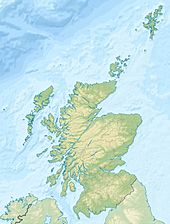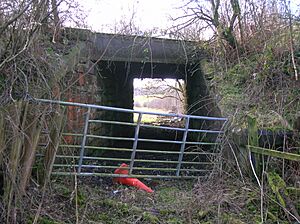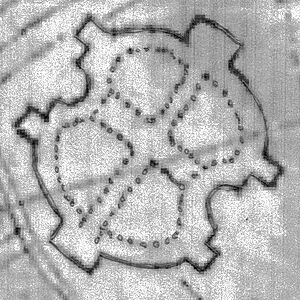Lands of Doura facts for kids
Quick facts for kids Lands of Doura |
|
|---|---|
| Kilwinning, North Ayrshire, Scotland UK |
|
| Coordinates | 55°38′58″N 4°37′54″W / 55.6495°N 4.6317°W |
| Grid reference | NS 34497 42702 |
| Type | Manor House |
| Site information | |
| Owner | Private |
| Controlled by | Clan Cunninghame |
| Open to the public |
No |
| Condition | Demolished |
| Site history | |
| Built | 17th century |
| Built by | Cuninghame family |
| Materials | Stone |
The Lands of Doura (also spelled Dawra, Dawray, Dowrey, Dowray, Dourey or Douray) was once a small estate in Scotland. It was located near the Eglinton Estate in a place called Kilwinning, in North Ayrshire. This area was once part of a larger property known as the Barony of Corsehill and Doura.
Contents
Doura Hall and Estate History
The name 'Doura' (and its different spellings) was used in several places across Ayrshire.
In 1361, a knight named Sir Hugh de Eglinton owned the lands of Doura. When he passed away, the lands went to the Montgomerie family of Eagleshame, because a Montgomerie married Sir Hugh's only daughter.
Later, in 1482, Doura was connected to Lord Boyd. It was part of the lands that his mother, Princess Mary (who was the sister of King James III), used to own.
Doura Hall: A Look at the Old Building
Doura Hall was a building from the 1600s. It stood on the road leading to Doura Mains farm. The Cuninghame family, who were the owners of Corsehill, had plans to build a new, grander house at Doura, but it never happened. However, the old plans still exist!
The hall was described as a simple building. It was taken down in the 1800s. You can still see reminders of the estate today, like Dovecote hill (where a dovecote, a home for doves, once stood) and Orchard Brae. The Cuninghame family of Corsehill owned this estate. There was also a smithy (a place where a blacksmith works) in the Doura area in the late 1700s.
In 1691, records show that Doura Hall had six fireplaces and was lived in by Lady Corsehill. The wider estate had sixteen other homes. Old maps from the 1700s and 1800s show the hall, an orchard, and other buildings. By 1856, the hall was marked as a ruin.
The name 'Doura' might come from 'Dollywraa', which means 'the enclosure of the Doleland'. Dole land was land that was shared by many owners, with each person having their own part marked out by special features.
The Barony Court: Local Justice in the Past
In the past, important landowners could hold their own local courts, called Barony Courts. In April 1669, Alexander Cuninghame of Corsehill held his court at 'Dawray'. These courts handled local disagreements and made sure people followed the rules.
For example, one case involved a coal miner named Thomas Miller and a smith named Hew Dyat. Hew had thrown a stone at Thomas. The court made Hew apologize to everyone and pay a fine. He also had to pay for Thomas's medical care. The court also reminded tenants to pay their rents on time.
In 1710, the court warned the tenants of Doura about several things. They were told not to hunt hares, doves, or partridges, and not to burn the moors (open land). They also couldn't poach salmon and trout when it was out of season. Another rule was not to cut 'greenwood' (fresh trees) or steep green lint (a plant used for linen) in running water.
Doura Mains Farm
Doura Mains Farm was first shown on a map in 1832. Doura Hall used to be located to the left of the farm's driveway. The farm was still there in 2013.
The Lairds: Owners of Doura
The owners of the Doura lands were called 'lairds'.
Andrew Cuninghame was the first of the Corsehill family to own Doura. In 1532, his father gave him the lands of Doura and Potterton. So, Doura became part of the Barony of Corsehill, which was owned by the Cuninghame family for centuries.
In 1551/2, a monk from Kilwinning Abbey named John Docheon signed a document giving lands at Doura to another John Docheon. Later, in 1611, Gilbert Docheon of Doura was owed money by someone living in Ireland.
Cuthbert Cuninghame inherited the estate and married Maud Cuninghame. They had two sons, Alexander and Patrick. Patrick was involved in a conflict and was later killed by the Montgomerie family in revenge.
The 4th Laird, Sir Walter Montgomerie-Cuninghame, lived at Doura in the 1780s. His family faced money problems because of the American War of Independence, and they lost their home at Lainshaw House.
In 1816, Sir James Cuninghame had to pay money towards rebuilding the tower at Kilwinning Abbey. The amount he paid showed that his estate was very valuable at the time, second only to the Earl of Eglinton's.
In 1870, Sir William James Montgomerie-Cuninghame became the owner of Corsehill and Kirktonholme, which included Doura. His family now lives in England.
Doura Village: A Community Grows and Changes
Doura was once a small village. The Annick Lodge school served the children of the village and nearby farms. The homes where miners lived have since been taken down.
In 1856, Doura had a village with a smithy. There was also a group of cottages called 'Winniebrae' nearby, with old mine pits marked on maps. By 1895, the Winniebrae cottages were no longer used, and another row of cottages at Laigh Doura was also abandoned. However, a brick and tile factory was still working, and local mines with railway connections were still active. The village was on the main Loch Libo Road and had about 350 people living there in the 1800s.
Industry: Coal Mining and More
The coal from Doura was known for its good quality for many years. The village for the miners had 350 people.
In the late 1700s, about 12 to 16 miners worked at Doura. Coal wagons would travel down to the town, and a small fee was charged for each cart. More was charged if the coal was taken to the coast to be shipped to Ireland.
One doctor, Dr. Duguid, said that the Doura pits hadn't been worked since the time of Mary Queen of Scots (1542–1587). He said they had supplied coal to Holyrood Palace and Edinburgh Castle. This might seem strange, but old mining methods often used up all the easily available coal. When the pit was drained later, old tools and even bones of the original miners were found at the coal face.
Dr. Duguid also described a later accident at the pit. After heavy frosts, the ground became loose, and the pit supports collapsed. One miner, Pate Brogildy, survived, but later lost his arm in an accident with the pit's steam engine. Another miner, Willie Forgisal, had his leg amputated. Sadly, James Jamphrey was killed instantly.
Records show that the coal at Doura included "ell" and "stone-coals." The Easter Doura mine employed 12 to 16 coal miners and was owned by Lord Lisle in the 1700s. He leased it for £140 per year.
The old orchard at Doura Hall gave its name to several coal and fireclay pits, and a stone quarry that closed in the late 1800s or early 1900s. A brick and tile factory was at Doura in 1895, and by 1908, a fireclay factory was also recorded.
The Doura Branch Railway: Moving Coal by Train
The Ardrossan and Johnstone Railway was an early railway line that opened in 1831. It was first used by horses pulling wagons between Ardrossan and Kilwinning. The railway used a special track width called "Scotch gauge" (4 feet 6 inches).
The Doura branch line, which was about 3 miles long, opened in 1834. It left the main line near Stevenston and went under another railway line to reach the Doura coal pit. There was also a shorter branch, about half a mile long, that went to the Fergus Hill coal pit.
Around 1833, Sir James Cunningham extended the Doura branch to his coal and fireclay workings at Perceton. Until the 1850s, horses still pulled the wagons, each carrying about a ton of coal. The Doura branch was privately owned until 1839, when the Ardrossan Railway Company took over.
In 1840, the railway tracks were upgraded to be stronger for steam locomotives. The track width was also changed to a standard size (4 feet 8½ inches). However, the tracks to the coal pits below Patterton Farm were not changed and were likely removed because those mines closed.
Later, a standard gauge railway line went down to the collieries (coal mines) at 'low' Doura. This line connected to the railway going to Perceton and served the fireclay, brickworks, and tileworks in the area, as shown on old maps.
Micro-history: Interesting Small Facts
Benslie Wood is a very unusual feature in the landscape. It was originally designed in a special, balanced shape near Benslie village, as shown on a map from the 1750s. It's outside the fancy gardens of the old Eglinton Estate. It looks like the foundations of a very large building, but it was actually made of trees with a raised bank around its edges. This bank might have had a fence or barrier on it at one time. Most of this unique feature is still there today.
In 1901, the coal pits at Doura were a good place to find Carboniferous fossils, which are remains of ancient life from a specific geological period.







